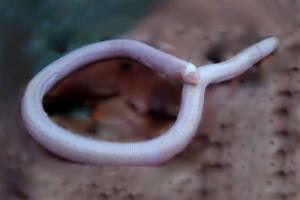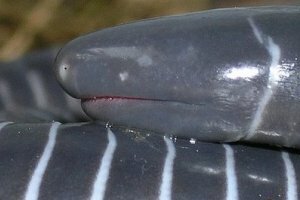The photo above is of a blind snake.
Do you know what kind of animal this is?
A) A snake, oh!
B) A kind of giant earthworm.
C) A legless lizard.
D) A two-headed snake.
E) A relative of the two-headed snake.
None of the answers are correct!
Blind snakes, or caecilians, are actually animals belonging to a group of amphibians: that of gymnophionos. Thus, they are not lizards or snakes, much less earthworms, as these, to begin with, are invertebrate animals. are not two-headed snakes: reptiles of the amphisbenid group.
 !
!
This name, blind snake, is given because the bodies of such animals are long, elongated and legless, like snakes. Furthermore, their eyes are so discreet that if we look quickly at one of these individuals, we have the impression that he is completely blind, apparently not possessing this structure. However, it is able to identify, through the eyes, changes in luminosity and, in addition, it has a structure, a tentacle, which allows it to perceive smells and vibrations.

The blind snake's eyes are almost “invisible”.
Other characteristics of blind snakes are that they have rings along the entire length of the body; and very moist skin, as do many other amphibians.
Most species of blind snakes live buried in the ground (they are therefore fossorial) and, thanks to their very hard head, they can dig galleries using this part of the body. They can be seen, albeit rarely, under wet, dry leaves: the litter.
Blind snakes feed mainly on invertebrates. In some cases, they are also able to eat other blind snakes. To do this, they use their teeth to capture prey and basically swallow them.
In our country there are at least 26 species of these animals, already registered by scientists!
Curiosity:
Some blind snakes, when hatchlings, feed on the mother's skin: a behavior called dermatophagia. Isn't that amazing?
By Mariana Araguaia
Biologist, specialist in Environmental Education
Kids School Team



